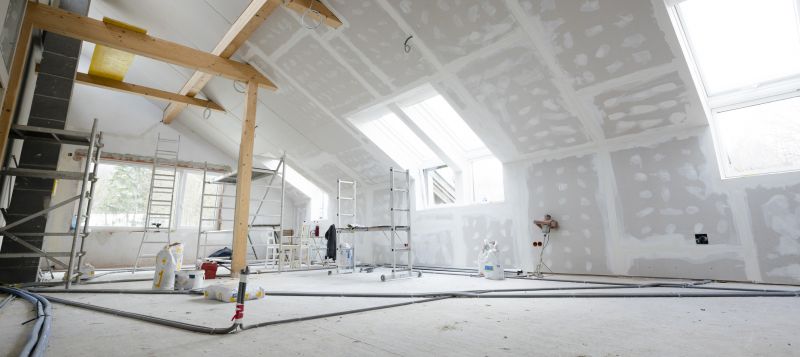Leading Products For Ceiling Drywall Replacements You Can Trust
Explore top-rated options designed to simplify ceiling repair projects with durability and ease of installation in mind.
 Ceiling drywall replacement products encompass a wide range of materials and tools designed to restore or improve ceiling surfaces. When selecting suitable options, it is important to consider the specific requirements of the project, such as the size of the damaged area, the ceiling's structural support, and the desired finish. Common materials include traditional drywall sheets, lightweight panels, and specialized repair products that facilitate seamless integration with existing surfaces. These products are often chosen for their ease of installation, durability, and ability to provide a smooth, uniform appearance after repair.
Ceiling drywall replacement products encompass a wide range of materials and tools designed to restore or improve ceiling surfaces. When selecting suitable options, it is important to consider the specific requirements of the project, such as the size of the damaged area, the ceiling's structural support, and the desired finish. Common materials include traditional drywall sheets, lightweight panels, and specialized repair products that facilitate seamless integration with existing surfaces. These products are often chosen for their ease of installation, durability, and ability to provide a smooth, uniform appearance after repair.
Top Overall Option
Standard Drywall Sheets
Standard drywall sheets are a versatile choice for ceiling replacement projects, offering a reliable surface that can be easily cut, installed, and finished. They provide a solid base for various textures and paint finishes, making them suitable for most ceiling repair or renovation needs. Their widespread availability and compatibility with common tools make them a practical option for DIY enthusiasts and professionals alike.
Types of Products For Ceiling Drywall Replacements
Standard Drywall Sheets
Traditional gypsum-based panels used for large ceiling areas and complete replacements.
Lightweight Ceiling Panels
Thin, easy-to-handle panels designed for quick installation and minimal weight load.
Flexible Drywall
Flexible gypsum boards that can bend to accommodate curved or arched ceilings.
Fire-Resistant Drywall
Specialized panels with fire-resistant properties suitable for certain building codes.
Soundproof Drywall
Panels designed to reduce sound transmission between rooms, ideal for multi-family or office spaces.
Textured Ceiling Replacement Panels
Pre-textured panels that match popular ceiling finishes for seamless repairs.
Ceiling Repair Patches
Self-adhesive patches for quick fixes of small ceiling damages.
Joint Compound and Tape
Essential for finishing seams and achieving a smooth surface after drywall installation.
Metal Framing Kits
Support structures for installing drywall panels on ceilings, especially in renovation projects.
Suspended Ceiling Tiles
Drop-in tiles suitable for creating a new ceiling surface or covering damaged areas.
PVC Ceiling Panels
Water-resistant panels that are lightweight and easy to install, suitable for humid environments.
Acoustic Ceiling Tiles
Panels designed to improve room acoustics while providing a finished ceiling surface.
Decorative Ceiling Panels
Stylish panels that add texture or pattern to ceiling surfaces for aesthetic enhancement.
Rigid Foam Board
Insulating panels that can also serve as ceiling surface replacements in certain applications.
Fiberglass Reinforced Panels
Durable panels resistant to moisture and impact, suitable for high-traffic areas.
Popular Choices
Widely used for ceiling replacements due to their versatility and ease of installation.
Preferred for quick installations and when weight is a concern.
Commonly chosen for small repairs and quick fixes on ceilings.
Popular for creating drop ceilings and covering large damaged areas.
Often selected for bathrooms and kitchens due to water resistance.
Trending for spaces requiring sound management and aesthetic appeal.
Chosen for matching existing decorative finishes on ceilings.
Popular for supporting drywall in renovation projects.
Valued for durability and moisture resistance in high-use areas.
Selected for aesthetic upgrades and feature ceilings.
Used for insulation and ceiling surface replacement in specific applications.
Chosen in areas where fire safety is a priority.
Popular in multi-room or office environments for noise reduction.
Often used to add visual interest to ceiling surfaces.
Selected for curved or arched ceiling designs.
For large-scale replacements, standard drywall sheets are typically used due to their availability and straightforward installation process. These sheets can be cut to size and fastened securely to ceiling joists, providing a sturdy base for finishing. For smaller patches or repairs, self-adhesive repair patches or joint compounds may be sufficient, offering quick solutions that minimize disruption. Advanced options also include fiber-reinforced panels and textured ceiling replacements, which can help match various ceiling styles and finishes.
Proper preparation is essential before installing ceiling drywall replacement products. This involves removing any loose or damaged material, cleaning the surface, and ensuring the underlying structure is sound. Once the new drywall or repair product is in place, finishing techniques such as taping, mudding, and sanding are employed to achieve a smooth, blemish-free surface. Painting or texturing then completes the repair, restoring the ceiling's aesthetic appeal. Selecting the right product for your specific ceiling type and repair scope will help ensure a lasting and visually appealing result.
Key Buying Considerations
- Size and dimensions of the replacement product to match existing ceiling areas.
- Material type based on environmental conditions such as humidity or temperature.
- Weight of the panels for ease of handling and structural support requirements.
- Compatibility with existing ceiling framing or support structures.
- Ease of installation, especially for DIY projects or limited access areas.
- Finish options including textures, patterns, and paintability.
- Fire resistance ratings if required by building codes or safety standards.
- Soundproofing qualities for spaces requiring noise control.
- Moisture resistance for bathrooms, kitchens, or other humid environments.
- Durability and impact resistance for high-traffic or commercial spaces.
- Cost and availability of replacement parts or panels.
- Compatibility with finishing materials like joint compounds, tapes, and paints.
- Environmental factors such as exposure to water, mold, or pests.
- Aesthetic considerations to match existing decor or design themes.
- Compliance with local building codes and safety regulations.
